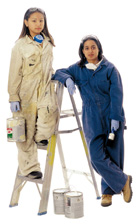
|
7 Things You'd Better Know True Tales of Health and Safety Your Stories Health and Safety Quiz Talk to Us Stuff Resources Book the YWA Program
|
Prev. 1 2 3 4 5 6 7 ? Next
 |
 | The Law protects |
| You have the legal right to protect your health and safety | ||
Laws and Regulations
Both the Ontario Government and the Government of Canada have laws to protect the health and safety of workers under their jurisdictions. These laws are called Acts.
An Act is general. It sets out what the law is about, whom it applies to and the penalties for disobeying it.
Some Acts have also have Regulations. Regulations are specific. They spell out all the details that you need to know in order to obey the law.
The Occupational Health & Safety Act
Most, but not all, Ontario workers are protected by the province�s Occupational Health and Safety Act or OHSA.(We�ll just call it the Act.)
The Act sets out general health and safety requirements for every workplace it applies to. Ontario's Ministry of Labour (MOL) enforces the Act, and MOL inspectors have strong powers to inspect workplaces and investigate accidents. They can also issue orders requiring changes to meet the Act's requirements and can order that a machine process be stopped until it complies with the Act.
MOL inspectors can also lay charges against companies or people breaking the law. If convicted, the person or company can be fined and/or put in jail.
The Act's Regulations
The Occupational Health and Safety Act has many Regulations that apply to specific occupations, types of workplaces and/or workplace hazards.
- For instance, there are specific regulations for occupations like firefighters, teachers and university academics.
- And there are regulations for specific workplaces such as health care facilities, industrial establishments, construction and mining.
- Then there are regulations to deal with certain kinds of hazards like biological agents and x-rays.
- Finally, there�s a Regulation that covers most hazardous materials and there are Regulations covering eleven especially dangerous materials called Designated Substances.
These Regulations are very detailed and they have the same legal force as the Act itself. The same penalties apply. You should know which, if any, of these Regulations apply to your job and workplace.
Federal laws
The federal government has responsibility for a wide range of workplaces. If you work in one of these locations, the federal government�s Canada Labour Code Part 2 and its Regulations protect your health and safety, not Ontario�s Occupational Health and Safety Act. However, the rules are very similar for both laws.
Three Rights
The Occupational Health and Safety Act gives every worker three important rights.
You have the Right To Know
You have the right to know the hazards in your job. Your employer or supervisor must tell you about anything in your job that can hurt you. Your employer must make sure you are provided with the information you need so that you can work safely.
You have the Right to Participate
You have the right to take part in keeping your workplace healthy and safe. Depending on the size of the company, you can be part of the Joint Health and Safety Committee (JHSC, or be a Health and Safety Representative.
You have the Right to Refuse Unsafe Work
If you believe the job is likely to endanger, you can refuse to do it in most situations.
Remember: Young workers who understand these rights and know how to use them are better able to protect themselves on the job. And remember, you can't be disciplined for exercising a right or responsibility.
Prev. 1 2 3 4 5 6 7 ? Next
[Health and Safety Quiz]|[Talk to Us]|[Stuff]|[Resources]|[Book the YWA Program]